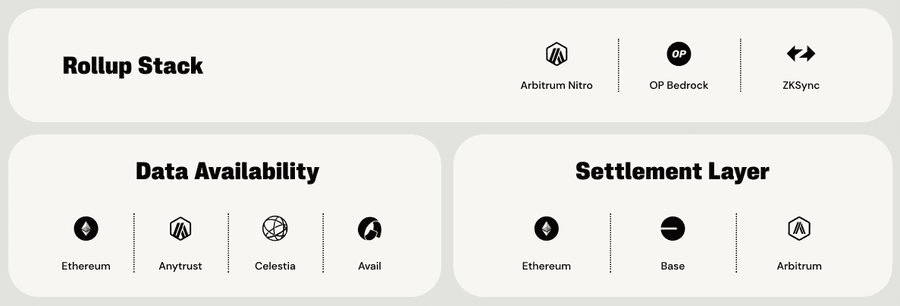I've been pondering a question lately: Is there perhaps too much L2?
Brothers, to be honest, we've been talking too much about modularity, L2 lately, and it's even a bit aesthetically tiring. Arbitrum, Optimism, zkSync, Starknet... each of them is great, but when a track is crowded with 'general-purpose' players, I always tend to think about a question:
'So what's next?'
We've all experienced it; when a new game or inscription explodes on a hot L2, the gas fees for the whole chain instantly soar, and the DeFi application you're using gets laggy. That feeling is terrible, right?
It's like everyone is squeezed onto a highway; no matter how wide the road is, there will still be traffic jams during peak hours.
At this point, the narrative of 'App-chains' starts to become particularly attractive. If I were a top gaming project or a high-frequency derivatives exchange, why wouldn't I create my own chain? I get to enjoy the performance, set the gas fees, and design the economic model myself. The departure of dYdX is the best proof.
But here's the problem: creating your own chain comes with a frighteningly high technical barrier, capital cost, and time cost. Ordinary developers simply can't handle it.
At this point, I discovered Caldera, and it all clicked.
Caldera: The 'AWS' and 'Shopify' of the blockchain world.
If I were to explain what Caldera does in one sentence, I would say:
It is a toolbox for 'one-click chain deployment', a Rollup as a Service (RaaS) platform.
Everyone is familiar with 'one-click server launch' in gaming, right? What Caldera does is something similar, but it serves developers. It makes launching a customized, high-performance Rollup chain as easy as opening an online store on Shopify.
🔸 Professional Time: How exactly does it work?
The core of Caldera is 'modularity' and 'customization.' Developers can freely combine their blockchain like playing with Legos:
Execution Layer: You can use OP Stack or Arbitrum Nitro, it's about which environment your application runs in.
Settlement Layer: You can choose to keep the final 'ledger' of transactions on the Ethereum mainnet, ensuring the strongest security, and in the future, you can choose other L1s.
Data Availability Layer (DA): This is the core of the modular narrative. You don't have to shove all data onto the expensive Ethereum, but can opt for 'data warehouses' like Celestia or EigenDA, drastically reducing costs.
Sequencer: Caldera provides a decentralized sequencer solution, making your chain more secure and resistant to censorship.
This 'menu-style' service directly lowers the barrier for chain deployment from 'hellish difficulty' to 'beginner's tutorial.'

Why do I personally pay special attention to it? (Human sentiment moment)
After discussing the technology, let's talk about something more practical. Why do I spend so much time studying it?
1. The narrative is big enough, and it follows the logic of 'selling shovels.'
In the gold rush, the most profitable are often not the gold miners, but those who sell water, jeans, and shovels. The war of L2 and application chains has begun, and Caldera is the top 'arms dealer.' No matter which game chain or DeFi chain succeeds in the future, as long as they are built using Caldera's services, Caldera is the winner. Such 'shovel' assets are very stable and imaginative in investing.
2. Endorsement by top capital.
Sequoia, Dragonfly... When these names appear on the investor list, it's hard not to pay attention. This isn't about being superstitious about VCs, but about these top institutions that invest in the future of the track and the best teams. Their due diligence is much deeper than that of ordinary users.
3. It might be a 'mining owner of airdrop gold mines.'
This might be the point everyone is most concerned about. Caldera itself, as an underlying infrastructure, has strong expectations for future token issuance. But more importantly, it has created a 'Caldera universe.'
In the future, countless project parties will launch their chains through Caldera, and in order to attract early users, will these new chains airdrop to Caldera's early supporters, or even to participants in the entire modular ecosystem?
This is a potential opportunity for 'one fish, multiple eats.' We focus not just on Caldera itself but on the whole ecosystem it empowers. For instance, Manta Network, which is already using Caldera technology, has partially validated this model.

Let's talk about it: Is this a bubble or the future?
Speaking of this, I also want to hear the opinions of the brothers in the square.
The future that Caldera envisions with 'thousands of chains launching simultaneously' is very grand, but it also raises some questions:
Liquidity fragmentation: With so many chains, will assets and users be overly dispersed? Can cross-chain experience and security keep up?
Homogeneous competition: When 'one-click chain deployment' becomes easy, will it lead to a large number of homogeneous, uninspired 'garbage chains'?
True moat: The RaaS track has also started to intensify; apart from first-mover advantage, where is Caldera's true moat?
I personally feel this is like the early days of the internet, where countless people could build websites using WordPress. There will definitely be a bubble, but ultimately, real giants will emerge and completely change the ecosystem of the entire industry.
Caldera feels like standing at the beginning of a new era. It's not a coin you can immediately trade on a DEX, but it's a fundamental change that is worth your time to understand and track.
Do you think RaaS will be the next core narrative? Or which project built on Caldera do you have more confidence in?





